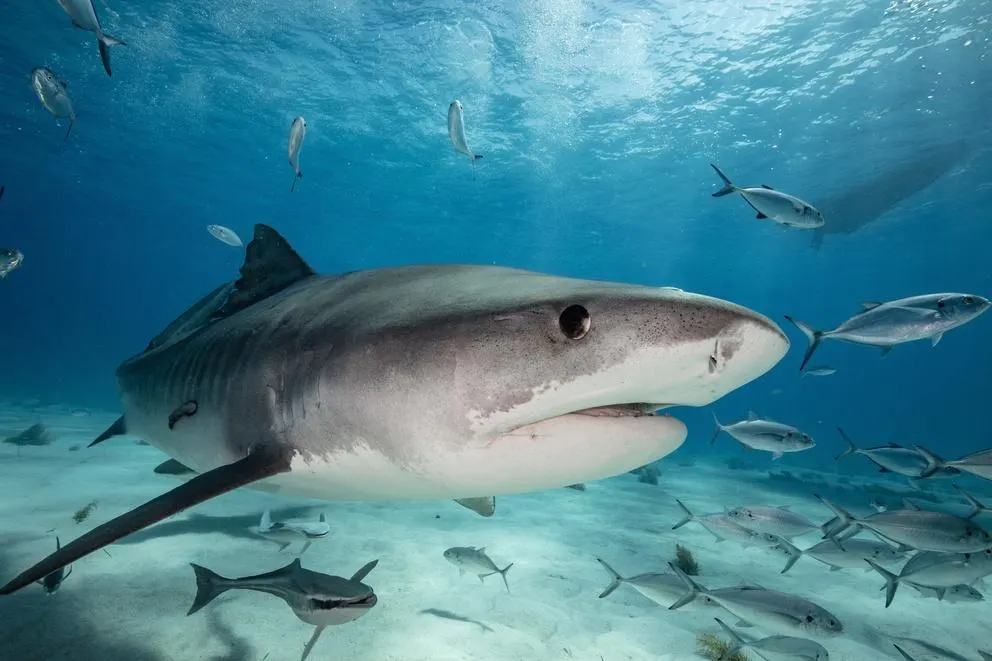By Contributor,Melissa Cristina Márquez
Copyright forbes

Populations of the iconic tiger shark, Galeocerdo cuvier, are in a state of global decline, with the species assessed as ‘Near Threatened’ on the IUCN Red List. Despite this, there is a lack of fundamental information required for regional management, such as those on life history and ecology. A new study has bridged this knowledge gap by generating the first information on the population dynamics of G. cuvier from the Arabian Sea – one of the world’s most important shark fishing regions.
The sun had barely risen over the Arabian Sea, casting a pale gold shimmer across the water as a small fishing boat rocked gently on the swells. The crew moved with practiced efficiency, muscles straining as they hauled the massive body onto the deck. Water sluiced from its mottled gray skin, pooling across the weathered wood, and the tail thumped weakly against the planks with a hollow, wet slap. Salt stung eyes and clung to skin, while the smell of brine and fish hung heavy in the air. One of the younger crewmen glanced at the shark with a mix of awe and routine acceptance, while most of the crew barely spared a glance; this was routine work in Cochin, India, where the sharks of the Arabian Sea had long been part of a thriving, high-stakes fishery. But despite this single tiger shark just being part of a routine day for those onboard, it actually represented a fragment of a larger story about a predator facing a precarious future.
Tiger sharks, Galeocerdo cuvier, are among the ocean’s most iconic predators, yet they are experiencing global population declines and the species is listed as ‘Near Threatened’ by the IUCN. Despite being one of the most recognizable of the shark species, there is a striking lack of fundamental data on their life history and ecology. This is especially true in regions like the Arabian Sea, one of the world’s most active shark fishing zones. Without this knowledge, regional management and conservation efforts are operating largely in the dark. To help remedy this, a recent study aimed to fill the gap by examining the population dynamics of tiger sharks in the Arabian Sea through landings at Kochin (also referred to as Cochin), on India’s southwest coast. Over 16 months in 2023 and 2024, researchers collected data from 629 individuals, providing a snapshot of the population being removed from these waters.
The fishing mortality (0.77) and exploitation rates (0.71) found paint a worrying picture, to start, indicating that tiger sharks in the Arabian Sea are under heavy pressure from fisheries. Even more alarming is the age and size of the sharks being caught. Analysis shows that roughly 95 percent of captured sharks are sexually immature with young-of-the-year sharks (measuring less than 150 centimeters total length) accounting for nearly a quarter of all landings, often as unintended bycatch. This pattern of targeting or incidentally catching juvenile sharks is a textbook example of growth and recruitment overfishing, where populations are depleted not because adults are being removed, but because the young are taken before they can contribute to making the next generation. Over time, this creates a population bottleneck: fewer sharks survive to adulthood, reproduction rates decline, and the overall population struggles to maintain itself. Even if adult sharks remain in the ecosystem, the loss of juveniles can lead to reduced genetic diversity and increased vulnerability to environmental changes.
Understanding which sharks are being removed is only part of the picture; the team next turned to length-frequency data to investigate how these catches reflect the population’s growth dynamics.
To grasp the full impact of intense fishing on the population here, it was essential to study not just who is being caught, but how these individuals grow and mature over time. Over 16 months in 2023–2024, researchers collected length-frequency data and found that most sharks fell in the 180–240 cm TL range, though the largest measured a remarkable 405 cm TL. To better understand the growth patterns, the researchers applied the von Bertalanffy growth model, a standard tool in fishery science used to describe how animals grow over their lifetime. Instead of assuming a constant growth rate, this model recognizes that growth is fastest when an animal is young and slows as it approaches its maximum size. By fitting the model to measurements of many sharks of different sizes, scientists can estimate key life-history parameters (such as the theoretical maximum length a shark can reach and how quickly it grows each year), which are crucial for understanding population dynamics, assessing vulnerability to fishing, and designing management strategies that help ensure enough sharks survive to reproduce. The estimated asymptotic length (the theoretical maximum size a tiger shark can reach) was 490.55 cm TL, which is larger than populations recorded in the Atlantic or Pacific Oceans. The growth coefficient (K) of 0.250 per year suggests that these sharks grow relatively quickly compared to their counterparts elsewhere. At first glance, this might seem like a positive sign, because faster-growing sharks can reach maturity sooner, potentially producing offspring earlier in life. However, this advantage is largely negated by heavy fishing pressure, especially since most of the sharks here caught are juveniles.
MORE FOR YOU
From a conservation perspective, it means that even though these sharks can grow quickly, their populations are still at high risk of decline because individuals are being removed before they can reproduce. While the picture may seem dire, the study also points toward actionable solutions. Protecting critical life stages through spatial and size-based regulations (such as establishing conservation zones, implementing size limits on catches, and reducing bycatch of young sharks) could help mitigate these risks. For example, establishing tiger shark conservation zones in areas known to serve as nurseries or key feeding grounds would allow juveniles to grow safely. And enforcing size limits on catches could prevent the overharvesting of immature sharks and help maintain population resilience. International collaboration and engagement with local fishing communities will be essential to implement these measures effectively.
While global assessments can provide general trends, region-specific studies are crucial because shark populations vary in size, growth rates, and vulnerability to fishing pressure. Without this information, management measures may be poorly targeted or insufficiently enforced. Thi study provides a much-needed baseline against which future population assessments can be measured because, going forward, local management strategies cannot rely on rapid growth alone to sustain this population. Essentially, knowing that they grow quickly informs management decisions in that it tells scientists where and when sharks are vulnerable but helps design regulations that allow them to survive long enough to maintain a healthy, reproducing population.
Tiger sharks have survived for millions of years, navigating oceans that have undergone immense changes. Yet today, human activity poses their greatest threat. These apex predators play a critical role in maintaining the balance of marine ecosystems by regulating prey populations and supporting biodiversity; declines in tiger shark numbers could have cascading effects throughout the food web, potentially altering entire marine communities. Thus, understanding the population dynamics of tiger sharks in regions like the Arabian Sea is a step toward ensuring that these predators continue to roam the seas, not just as symbols of marine power, but as functioning parts of a healthy ecosystem. And that’s priceless.
Editorial StandardsReprints & Permissions



